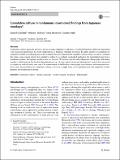Files in this item
Cumulative culture in nonhumans : overlooked findings from Japanese monkeys?
Item metadata
| dc.contributor.author | Schofield, Daniel P. | |
| dc.contributor.author | McGrew, William C. | |
| dc.contributor.author | Takahashi, Akiko | |
| dc.contributor.author | Hirata, Satoshi | |
| dc.date.accessioned | 2018-01-11T10:30:16Z | |
| dc.date.available | 2018-01-11T10:30:16Z | |
| dc.date.issued | 2018-03 | |
| dc.identifier | 252025666 | |
| dc.identifier | b4004758-50e6-4535-bf2d-7424e77ca5fa | |
| dc.identifier | 85039855079 | |
| dc.identifier | 000427064900002 | |
| dc.identifier.citation | Schofield , D P , McGrew , W C , Takahashi , A & Hirata , S 2018 , ' Cumulative culture in nonhumans : overlooked findings from Japanese monkeys? ' , Primates , vol. 59 , no. 2 , pp. 113-122 . https://doi.org/10.1007/s10329-017-0642-7 | en |
| dc.identifier.issn | 0032-8332 | |
| dc.identifier.uri | https://hdl.handle.net/10023/12463 | |
| dc.description | The authors thank Corpus Christi College (Cambridge) for funding DS’s visit to Koshima and Prof. Tetsuro Matsuzawa for funding WCM’s visit to Koshima. | en |
| dc.description.abstract | Cumulative culture, generally known as the increasing complexity or efficiency of cultural behaviors additively transmitted over successive generations, has been emphasized as a hallmark of human evolution. Recently, reviews of candidates for cumulative culture in nonhuman species have claimed that only humans have cumulative culture. Here, we aim to scrutinize this claim, using current criteria for cumulative culture to re-evaluate overlooked qualitative but longitudinal data from a nonhuman primate, the Japanese monkey (Macaca fuscata). We review over 60 years of Japanese ethnography of Koshima monkeys, which indicate that food-washing behaviors (e.g., of sweet potato tubers and wheat grains) seem to have increased in complexity and efficiency over time. Our reassessment of the Koshima ethnography is preliminary and nonquantitative, but it raises the possibility that cumulative culture, at least in a simple form, occurs spontaneously and adaptively in other primates and nonhumans in nature. | |
| dc.format.extent | 10 | |
| dc.format.extent | 1177273 | |
| dc.language.iso | eng | |
| dc.relation.ispartof | Primates | en |
| dc.subject | Cumulative culture | en |
| dc.subject | Ethnography | en |
| dc.subject | Food processing | en |
| dc.subject | Japanese macaque | en |
| dc.subject | Traditions | en |
| dc.subject | QL Zoology | en |
| dc.subject | BF Psychology | en |
| dc.subject | Animal Science and Zoology | en |
| dc.subject.lcc | QL | en |
| dc.subject.lcc | BF | en |
| dc.title | Cumulative culture in nonhumans : overlooked findings from Japanese monkeys? | en |
| dc.type | Journal item | en |
| dc.contributor.institution | University of St Andrews. School of Psychology and Neuroscience | en |
| dc.contributor.institution | University of St Andrews. Centre for Social Learning & Cognitive Evolution | en |
| dc.identifier.doi | 10.1007/s10329-017-0642-7 | |
| dc.description.status | Peer reviewed | en |
This item appears in the following Collection(s)
Items in the St Andrews Research Repository are protected by copyright, with all rights reserved, unless otherwise indicated.

